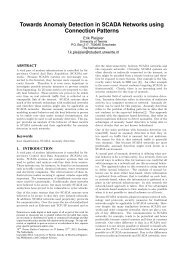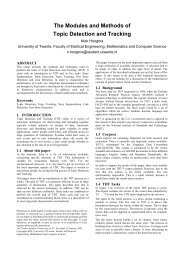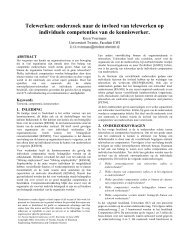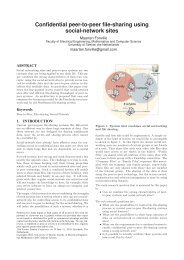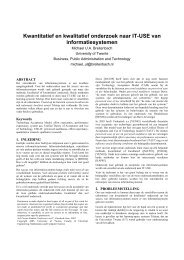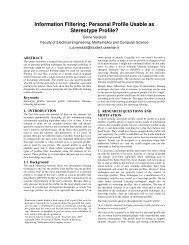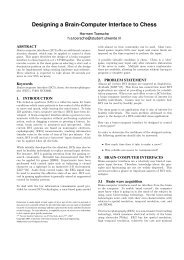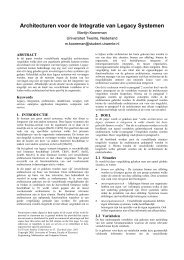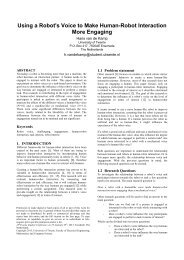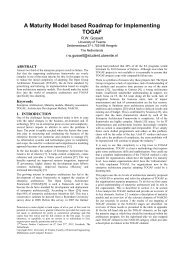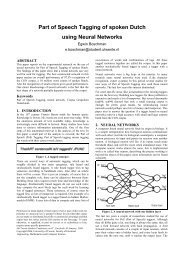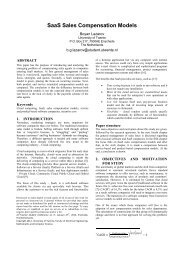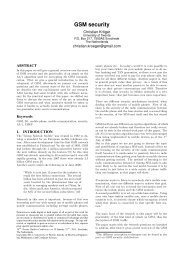Proceedings Template - WORD - Twente Student Conference on IT
Proceedings Template - WORD - Twente Student Conference on IT
Proceedings Template - WORD - Twente Student Conference on IT
You also want an ePaper? Increase the reach of your titles
YUMPU automatically turns print PDFs into web optimized ePapers that Google loves.
RSU so they have a higher priority. Also the RSSI (Received<br />
signal Strength Indicati<strong>on</strong>) and transmissi<strong>on</strong> power can be used<br />
to measure the distance between the RSU and the vehicles.<br />
Based <strong>on</strong> this distance a priority class from EDCA will be<br />
chosen. Vehicles that are closer to the RSU, and within the near<br />
area, will use a higher EDCA priority class, than vehicles in the<br />
far area. Lower priority traffic has to perform carrier sensing for<br />
a l<strong>on</strong>ger time, so it can happen that higher priority traffic has<br />
already claimed the channel, see Secti<strong>on</strong> 2.1<br />
packets at the start of the SCH, because the nodes switch<br />
independently of each other.<br />
Figure 15. Broadcast coverage of the nodes in the near part,<br />
copied from [9]<br />
This scheme is not focussing <strong>on</strong> minimizing the impact of<br />
channel switching <strong>on</strong> the IEEE 802.11p beac<strong>on</strong>ing (i.e., CCH)<br />
performance. Furthermore, it is not standardized and its<br />
complexity is high. The Exploitable node-assisted WBSS<br />
Broadcasting mechanism makes it possible for newly coming<br />
vehicles to c<strong>on</strong>nect faster to a RSU. The RSU have to send less<br />
‘administrative packets’ and can send more useful packets to<br />
enhance to cooperative awareness. However it comes with the<br />
cost that nodes need to calculate their relative locati<strong>on</strong> to the<br />
RSU. Furthermore, in order to make full use of the Exploitable<br />
Node-Assisted WBSS Broadcast Mechanism all vehicles should<br />
support this mechanism.<br />
4.5 Adaptive Independent Channel<br />
Switching Mechanism<br />
While the number of nodes increases, more packets are<br />
generated and the channel could become c<strong>on</strong>gested. This means<br />
that the queuing and c<strong>on</strong>tenti<strong>on</strong> delay of packets increases, as<br />
the channel gets more c<strong>on</strong>gested. Simulati<strong>on</strong>s experiments in<br />
[18] indicated that for a c<strong>on</strong>gesti<strong>on</strong> window greater than 64 and<br />
a number of nodes greater then 20, the transmissi<strong>on</strong> times for<br />
the nodes to complete their transmissi<strong>on</strong>s becomes higher than<br />
50 ms. This means that the CCH interval defined in IEEE<br />
1609.4 is too short. In [18] a different channel switching<br />
mechanism is presented, namely the Adaptive Independent<br />
Channel Switching Mechanism (AICSM). In the AICSM all<br />
nodes can independently of each other change their average<br />
switching time, based <strong>on</strong> the vehicle density. As so<strong>on</strong> as a node<br />
finishes its CCH transmissi<strong>on</strong>s and its average switching time<br />
has elapsed it changes to the SCH. The AICSM is illustrated in<br />
Figure 16.<br />
In this switching schema the SCH performance is much better,<br />
at the cost of CCH performance, for several reas<strong>on</strong>s. The SCH<br />
interval will often be l<strong>on</strong>ger than the 50 ms. specified in IEEE<br />
1609.4. This means that more packets can be sent during the<br />
SCH transmissi<strong>on</strong> time, because nodes will switch faster to the<br />
SCH than others. Also, this results in fewer collisi<strong>on</strong>s between<br />
Figure 16. Adaptive Independent Channel Switching<br />
Mechanism, copied from [18]<br />
This scheme is not focussing <strong>on</strong> minimizing the impact of<br />
channel switching <strong>on</strong> the IEEE 802.11p beac<strong>on</strong>ing (i.e., CCH)<br />
performance. Moreover, this soluti<strong>on</strong> is not standardized.<br />
Because of the fact that nodes can independently of each other<br />
implement an adaptive independent channel switching<br />
mechanism, it is very scalable. Therefore its complexity is low,<br />
because a node <strong>on</strong>ly has to find out how many nodes are using<br />
the channel and change its average switching time based <strong>on</strong> its<br />
findings.<br />
5. CONCLUSIONS AND FUTURE WORK<br />
This paper provided an analysis of the beac<strong>on</strong>ing performance<br />
of IEEE 802.11p using the channel switching procedures of<br />
IEEE 1609.4. Both the c<strong>on</strong>tinuous scenario and alternating<br />
scenario are evaluated in OMNeT++, using a varied number of<br />
nodes, queue lengths and buffering mechanisms. Also an<br />
overview is given of soluti<strong>on</strong>s that improve the performance of<br />
IEEE 802.11p using the IEEE 1609.4 channel switching<br />
procedures.<br />
In Secti<strong>on</strong> 2 an answer is given to research questi<strong>on</strong>s (1) and (2)<br />
by providing an overview of the specificati<strong>on</strong>s of IEEE 802.11p<br />
and IEEE 1609.4. Secti<strong>on</strong> 3 answers the research questi<strong>on</strong>s (3)<br />
and (4) by providing an overview of the simulati<strong>on</strong> experiments<br />
in which the impact of the channel switching procedures,<br />
defined in IEEE 1609.4 are evaluated. Secti<strong>on</strong> 4 answers<br />
research questi<strong>on</strong> (5) by providing an overview of the soluti<strong>on</strong>s<br />
that are designed to minimize the impact of the IEEE 1609.4<br />
channel switching procedures <strong>on</strong> the IEEE 802.11p (mainly <strong>on</strong><br />
SCH) performance.<br />
As seen in secti<strong>on</strong> 3, using the alternating scenario results in a<br />
lower recepti<strong>on</strong> probability and a higher end-to-end delay of<br />
beac<strong>on</strong>s already for a small number of nodes. The recepti<strong>on</strong><br />
probability decreases and the end-to-end delay increases as the<br />
number of nodes increases. This is because the channel<br />
becomes more c<strong>on</strong>gested as more nodes are transmitting<br />
beac<strong>on</strong>s. If the number of nodes exceeds 120 nodes the average<br />
end-to-end delay is smaller for the alternating scenario than the<br />
c<strong>on</strong>tinuous scenario, because the channel has saturated faster.<br />
As the number of nodes increases, the end to end delay for the<br />
c<strong>on</strong>tinuous scenario also increases. However as the number of<br />
nodes increases, for both c<strong>on</strong>tinuous and alternating scenario<br />
fewer beac<strong>on</strong>s are received successfully.<br />
In the simulati<strong>on</strong>s, two buffering mechanisms are compared,<br />
namely OPD and NPD. It can be c<strong>on</strong>cluded that both buffering<br />
mechanisms perform equally well under the test circumstances.<br />
In the simulati<strong>on</strong>s different queue lengths are used, namely a<br />
queue length of 1, 2 and 5. From the simulati<strong>on</strong>s it can be<br />
c<strong>on</strong>cluded that a different queue length has no influence <strong>on</strong> the<br />
recepti<strong>on</strong> probability and the end-to-end delay of the beac<strong>on</strong>s,



